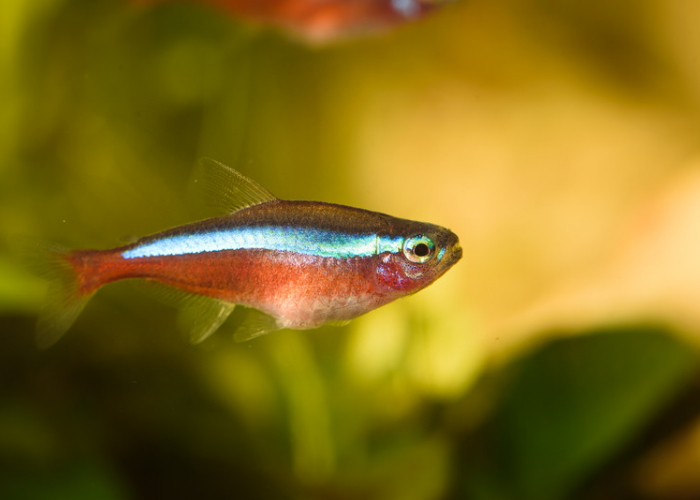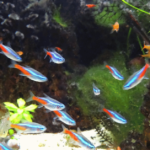Introduction
Are you a beginner aquarist looking for the perfect tropical fish to start your aquarium journey? Look no further than the vibrant and captivating neon tetra! These small schooling fish are not only stunning to look at but also relatively easy to care for, making them an ideal choice for novice fish keepers.
What are Neon Tetras?
Neon tetras (Paracheirodon innesi) are small, freshwater fish native to the Amazon River basin in South America. They are recognized for their placing look, with a shiny blue horizontal stripe jogging along their iridescent silver bodies and a vibrant purple stripe below it.
Why Neon Tetras are Great for Beginners
Neon tetras are an excellent choice for beginner aquarists because they are hardy, adaptable, and easy to care for. They are also peaceful and can coexist with other non-aggressive fish species, making them perfect for community tanks.
Neon Tetra Basics
Before diving into the care guide, let’s cover some basic information about neon tetras.
Appearance and Size
Adult neon tetras typically reach a size of 1.5 inches (4 cm) in length. Their slender bodies are adorned with a neon blue stripe and a red stripe, making them stand out in any aquarium.
Lifespan
With proper care, neon tetras can live as long as five years in captivity. Providing them with a properly maintained tank and a balanced diet will help ensure they live a protracted and healthy life.
Behavior
Neon tetras are schooling fish, meaning they thrive in groups of at least six individuals. In the wild, they form schools as a defense mechanism against predators and for better foraging opportunities. In the aquarium, schooling behavior helps reduce stress and promotes natural behavior.
Setting Up the Ideal Neon Tetra Tank
Creating the perfect environment for your neon tetras is crucial for their health and well-being. Here’s what you need to know:
Tank Size and Shape
A 10-gallon tank is the minimal length advocated for a school of neon tetras. However, a 20-gallon long tank is good, because it provides more swimming area and replicates their natural habitat.
Filtration and Heating
Neon tetras require clean, nicely filtered water to thrive. A gentle filter that doesn’t create an excessive amount of modernity is nice, as neon tetras opt for slow-moving waters. A heater is also necessary to maintain a strong water temperature between 70-81°F (21-27°C).
Substrate and Decorations
A dark substrate, together with black sand or gravel, will help exhibit the neon tetras’ colorful shades. Adding stay flowers, driftwood, and rocks will now not only most effectively create a visually appealing aquascape but additionally provide hiding spots and make your tetras experience extra domestic.
Plants
Some great plant options for a neon tetra tank include Java moss, Amazon sword, and Anubias. These plants provide shelter and help maintain good water quality.
Driftwood and Rocks
Including driftwood and rocks in your aquarium will create a natural-looking environment for your neon tetras. Make sure to pick clean, aquarium-safe rocks and driftwood that have been properly organized to avoid affecting water parameters.
Lighting
Neon tetras choose subdued lighting fixtures, as they inhabit shaded regions inside the wild. A low-wattage LED light or a dimmer can help create the right lighting situation for your tetras.
Water Parameters for Neon Tetras
Maintaining proper water parameters is essential for the health and well-being of your neon tetras. Here’s what you need to know:
Temperature
As mentioned earlier, neon tetras thrive in water temperatures between 70-81°F (21-27°C). Use a reliable aquarium thermometer to monitor the temperature and make certain it remains strong.
pH Level
Neon tetras choose barely acidic water with a pH range of 6.0-7.0. You can use a pH check kit to regularly test the pH ranges in your tank and make changes as needed.
Hardness
Neon tetras do best in gentle to fairly hard water, with a hardness range of 1–10 dGH. If your tap water is too tough, you may use a water softener or mix it with distilled water to achieve the preferred hardness stage.
Tankmates for Neon Tetras
Neon tetras are peaceful fish that can coexist with other non-aggressive species. Here are some compatible tankmates to consider:
Other Tetra Species
Neon tetras can be kept with other tetra species, such as cardinal tetras, black neon tetras, and green neon tetras. These species have similar care requirements and can create a stunning display when kept together.
Cardinal Tetras
Cardinal tetras (Paracheirodon axelrodi) are barely larger than neon tetras and feature a more sizable purple stripe that runs the length of their bodies. They make notable tankmates for neon tetras and can be kept inside the identical faculty.

Black Neon Tetras
Black neon tetras (Hyphessobrycon herbertaxelrodi) have a similar appearance to ordinary neon tetras but with a black stripe as opposed to a blue one. They are peaceful and can be saved with neon tetras in a network tank.
Green Neon Tetras
Green neon tetras (Paracheirodon simulans) are less common than regular neon tetras but equally stunning. They have a green, iridescent stripe instead of a blue one and can be kept with other peaceful tetra species.
Other Compatible Fish
Other fish species that can coexist peacefully with neon tetras include:
- Guppies
- Platies
- Mollies
- Corydoras catfish
- Otocinclus catfish
- Harlequin rasboras
Incompatible Fish
Avoid retaining neon tetras with larger, aggressive fish that can view them as prey, together with cichlids or bettas. Also, steer clear of fin-nipping species like tiger barbs, as they can pressure out and injure your neon tetras.
Feeding Neon Tetras
Providing your neon tetras with a balanced and varied diet is essential for their health and vibrant coloration. Here’s what you need to know about feeding your tetras:
Flake Foods
High-quality flake foods designed for tropical fish can form the base of your neon tetras’ diet. Look for flakes that contain a variety of ingredients, such as spirulina and other plant-based materials, to ensure your tetras receive all the necessary nutrients.
Frozen and Live Foods
Supplementing your neon tetras’ weight-reduction plan with frozen or fresh ingredients, along with brine shrimp, daphnia, and bloodworms, will offer them extra protein and encourage their natural foraging behavior. Offer these treats a few times every week in addition to their everyday flaky food.
Feeding Frequency
Feed your neon tetras small amounts of food two to three times a day. Only offer as much as they can consume within 2–3 minutes to avoid overfeeding and maintain good water quality.
Common Neon Tetra Diseases
Like all fish, neon tetras are susceptible to certain diseases. Here are some common health issues to watch out for:
Neon Tetra Disease
Neon tetra disease is a fatal situation as a result of a microsporidian parasite. Infected fish may also show a lack of coloration, a curved backbone, and problems swimming. Unfortunately, there’s no known therapy for this disease, and affected fish need to be removed and humanely euthanized to prevent the spread of the parasite.
Fin Rot
Fin rot is a bacterial infection that causes the fins to appear frayed or ragged. Poor water quality and stress are common causes of fin rot. Improving water conditions and using antibacterial medications can help treat the infection.
Ich
Ich, or white spot disease, is caused by a parasitic protozoan that appears as small white spots on the fish’s body and fins. Raising the water temperature and using ich-specific medications can help treat the disease.
Breeding Neon Tetras
Breeding neon tetras can be a rewarding experience for more advanced aquarists. Here’s a brief overview of the breeding process:
Preparing a Breeding Tank
Set up a separate breeding tank with soft, acidic water and a temperature around 75°F (24°C). Include fine-leaved plants, such as Java moss, for the eggs to adhere to.
Encouraging Spawning
To encourage spawning, provide your adult neon tetras with first-rate meals and perform a big water change with barely cooler water. Place a pair of healthy, mature tetras within the breeding tank and provide a spawning mop or best-leaved flora.
Caring for Neon Tetra Fry
Once the eggs hatch, remove the adult tetras to prevent them from eating the fry. Feed the fry small live foods, such as infusoria and newly hatched brine shrimp, until they are large enough to accept crushed flake food.
Conclusion
Neon tetras are a fantastic choice for beginner aquarists looking to add a splash of color and life to their tanks. By providing them with a well-maintained aquarium, a balanced diet, and compatible tankmates, you can enjoy these vibrant fish for years to come. Remember to keep an eye on water parameters, watch for signs of disease, and give your tetras plenty of hiding spots and swimming space to keep them happy and healthy.
How many neon tetras should I keep together?
Neon tetras are schooling fish and should be kept in groups of at least six individuals. Keeping them in larger groups will help them feel more secure and display their natural behaviors.
Can I keep neon tetras with bettas?
It is not recommended to keep neon tetras with bettas, as bettas can be aggressive and may view the tetras as prey. It’s best to keep neon tetras with other peaceful, similarly-sized fish.
How often should I feed my neon tetras?
Feed your neon tetras small amounts of food two to three times a day. Only offer as much as they can consume within 2–3 minutes to avoid overfeeding and maintain good water quality.
What should I do if my neon tetras get sick?
If your neon tetras show signs of illness, such as lethargy, loss of appetite, or visible symptoms like white spots or frayed fins, isolate the affected fish in a separate tank and treat with the appropriate medication. Consult a veterinarian or experienced aquarist for guidance.
Can I breed neon tetras in my community tank?
It is not recommended to breed neon tetras in a community tank, as the eggs and fry may be eaten by other fish. Set up a separate breeding tank with the appropriate conditions to increase the chances of successful breeding.
How long do neon tetras live?
With proper care, neon tetras can live up to 5 years in captivity. Providing them with a well-maintained tank and a balanced diet will help ensure they live a long and healthy life.
What is the ideal water temperature for neon tetras?
Neon tetras thrive in water temperatures between 70-81°F (21-27°C). Use a reliable aquarium thermometer to monitor the temperature and ensure it remains stable.
Can I keep neon tetras with goldfish?
No, it is not recommended to keep neon tetras with goldfish. Goldfish require cooler water temperatures and produce a significant amount of waste, which can negatively impact the water quality for neon tetras. Additionally, goldfish may attempt to eat the smaller tetras.
How often should I change the water in my neon tetra tank?
Perform a 10-15% water change once a week to maintain good water quality. Use a gravel vacuum to remove debris and waste from the substrate during the water change.
What plants are best for a neon tetra aquarium?
Some great plant options for a neon tetra tank include Java moss, Amazon sword, and Anubias. These plants provide shelter, help maintain good water quality, and create a natural-looking environment for your tetras.



Pingback: Top 10 Most Popular Freshwater Fish for Beginners
Pingback: Betta Fish Care: Expert Tips for Beginners and Pros Alike